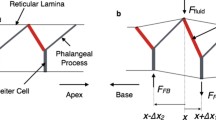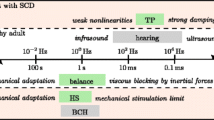Abstract
We present a quantitative mathematical model that represents the main features of the bullfrog inner ear. Calculated responses based on this model predict the observed frequency separation between the amphibian papilla and basilar papilla responses. The origin of this separation can be traced to the effect of the contact membranes on the impedance of the respective paths. Additionally, we calculated the input impedance of the periotic canal and showed that at low frequencies it acts as a bypass for most of the energy entering the ear, shunting it away from the amphibian-basilar papilla complex. As this shunting decreases with increasing frequency, we propose that the periotic canal functions as a protection mechanism to prevent overload of the amphibian papilla and basilar papilla during ventilation and for quasi-static pressure equalization. Our model explains the main features of the empirical data obtained from direct measurement of the amphibian papilla and basilar papilla contact membranes reported in an accompanying paper (this issue).
Similar content being viewed by others
Author information
Authors and Affiliations
Additional information
Accepted: 9 March 2000
Rights and permissions
About this article
Cite this article
Purgue, A., Narins, P. A model for energy flow in the inner ear of the bullfrog (Rana catesbeiana). J Comp Physiol A 186, 489–495 (2000). https://doi.org/10.1007/s003590050447
Issue Date:
DOI: https://doi.org/10.1007/s003590050447




